Church of the Immaculate Conception
Church of the Immaculate Conception
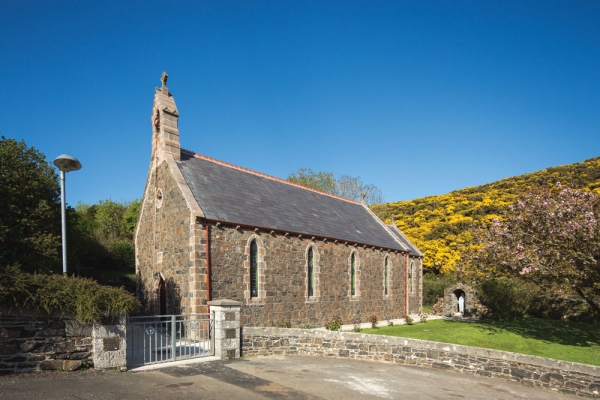
Early monastic and church history
Throughout the centuries islanders have gathered in prayer and worship, and taken part in popular devotions such as pilgrimages. The island dominated a strategic location for seafarers and was therefore on the communication highway of the western world of the early centuries. So the topography and landscape lays claim to significant visitors and to monastic sites, the centres of excellence of their time.
• Oral tradition concerning the local townland of Kilpatrick has it that St Patrick or one of his disciples passed here.
• Visits by St Columcille, who left Derry for Iona in 563 to settle disputes, also form part of local lore – and this may well be true, for monks and the location of monastic settlements were often guarantors of settlements, or mediators as we would call them today.
• St Comghall, famous abbot of Bangor, tried to establish a Church, or a monastic settlement, on Rathlin and it is claimed that he did so on the occasion of his second visit in 580, around the time St Columbanus departed Bangor with his followers for the European continent on his peregrinatio pro Christo. This links Rathlin with the Bangor of the famous monastic rule (Benchuir bona regula) and abbey school, ultimate source of Columban monasticism in present day France.
• In the following century, in 635, Segene, abbot of Iona, established a Church here as Rathlin came under the care of Iona.
So the island boasts a number of monastic sites: Cill Bhride at Ballygill, Cill na Bhruain in Knockans, where the monk’s or saint’s seat is still visible, Cill na Bhruain in Carrivindoon, and Kilpatrick with the main St Comghall’s monastic settlement having been on the site of St Thomas’s Church of Ireland. None of this should surprise us for the seas and waterways were the highways of communication and commerce, and for the spread of ideas, skills, culture and religious faith in those bygone ages.
Prior to the existence of the church, in penal times, Mass was celebrated under the shade of an overhanging rock in a mountain grazing in Ballynagard. The principal Mass Station (or Mass Rock in island parlance) was a large stone in Kilpatrick. There was another in a hollow place named Lad-na-Sassanagh (meaning the ‘Englishman’s Hollow’), which got its name from an English blacksmith who had his forge there. People also met for Mass in the site of an old mill purchased from Robert Gage, whose family had bought the island from Lord Antrim in 1746 for £1,750. And it was this old mill which became the site of Church of the Immaculate Conception.
The Church of the Immaculate Conception – history of the church building
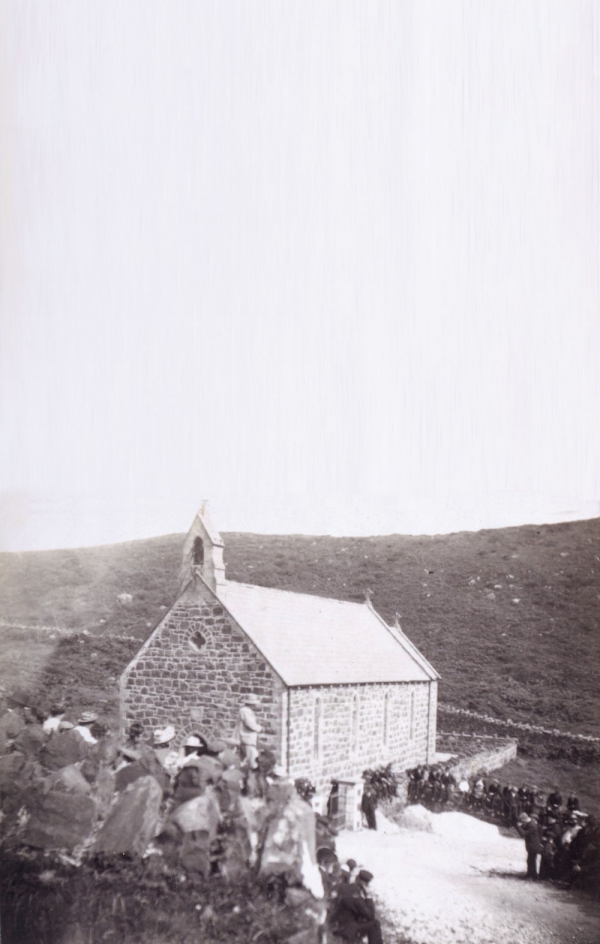
In 1816 the old mill and threshing barn was purchased for £48 by a Mr Alexander McDonnell and converted by Father Loughery into a little church, which was replaced by the present structure. When the mill was purchased Mr. Gage ceded his landlord rights in favour of his Catholic tenancy.
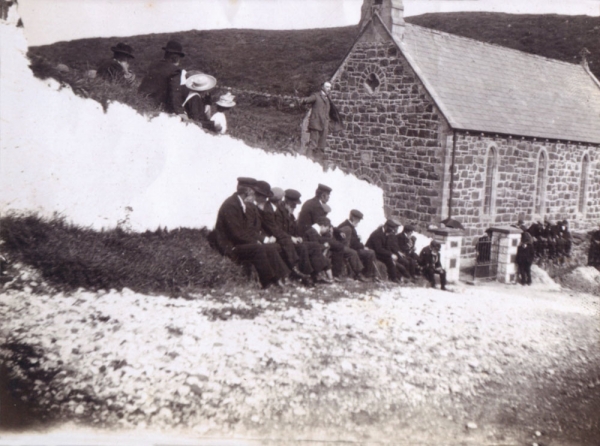
In 1864 Fr Michael McCartan erected the present building. When it was enlarged it was 48 feet long, 18 feet broad and 14 feet high. Across one third of it was a gallery; nearly all of its timbers had been portions of vessels which had been shipwrecked on the island. It was dedicated in 1865 by Bishop Patrick Dorrian. The old chapel’s stone walls are still visible, as well as the stone steps at the back which lead to the Parochial House. The contractor was Michael McMichael, and Neil McCurdy was the stone mason.
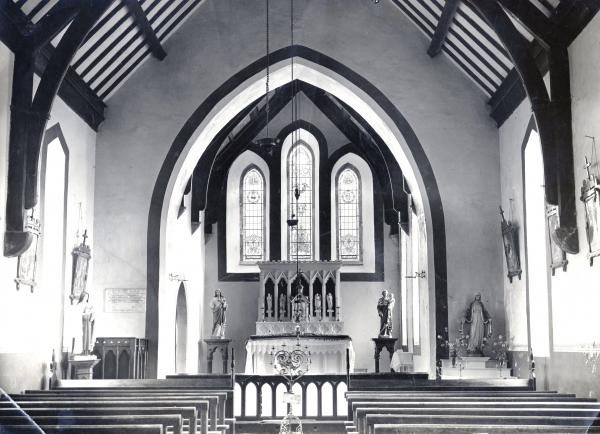
The property is a single storey construction with part gallery. The roof is slated on timber rafters, timber purlins and raised collar timber trusses. The gallery is in timber joists spanning off the front gable wall to a steel beam spanning clear across the nave. The walls are in non-cavity stone with sandstone reveals to the windows and doors. The floor is in solid construction and is ground bearing. A small bell is housed at the peak to the front gable.

The church is located on an elevated and exposed site. It is surrounded by a low stone wall to the south, adjoining the road and to the rear north there is a stone retaining wall. The stained-glass windows are Italian and were originally installed by Italian craftsmen. The plaque mounted on the wall at back of the church has a list of resident priests dating back to 1740. The bell is supported in an open bell gable structure built in stone – the bell is in a small hollow semi-circular arch.
The grotto
The grotto in front of the church was built by Islanders. The stones were brought by cart from Ushet. The surrounding walls were made of leftover stones. The archway was first built in wood to act as a mould. Stones were placed over it and the wooden structure removed. The statue was bought by Fr O’Hare in Belfast in the 1930’s.
The gallery
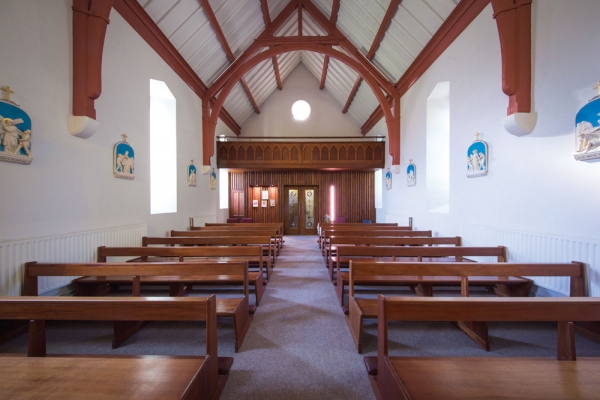
The gallery was added in 1932 by Peter and Neilly Dallat of Ballycastle. The Dallat family still conducts funerals on Rathlin. Once the gallery was built, an organ was bought for the chapel. It was usually the teacher who played the organ - Sally Black née McPoland. She was taught to play by Miss Smith, another teacher on the island.
Island memories of Mass
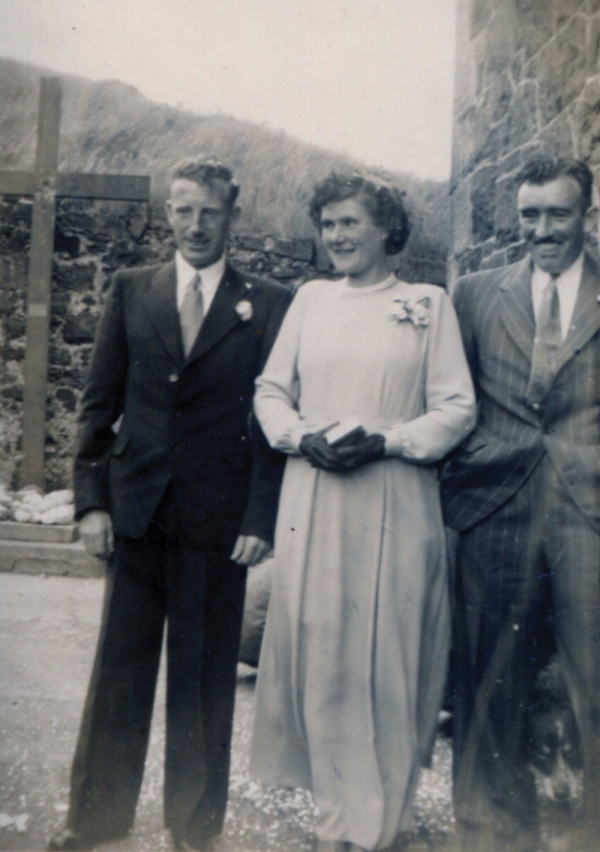
Loughie McQuilkin, who was born in 1923, described in his book how, in his day, looking up the aisle of the church, the altar was set back against the wall with the tabernacle incorporated. At the foot of the steps was the altar rail and there was a small pulpit on the left hand side with a large candelabra to the side of that. A statue of Our Lady with a small altar was on the right. Father Michael Murray is buried under the altar. The choir stood at the back of the church to the right on a raise wooden area. The confession boxes were to the left. Mass was daily on weekdays at 8.30a.m. and twice on Sundays. All the school children had to go to 8.30a.m. Mass on Saturday. Traditionally the ladies sat on the left and the men on the right. Christmas Day Mass was at 6.30a.m. Mass was in Latin and there was always a sung Mass on Feast Days and Holidays.
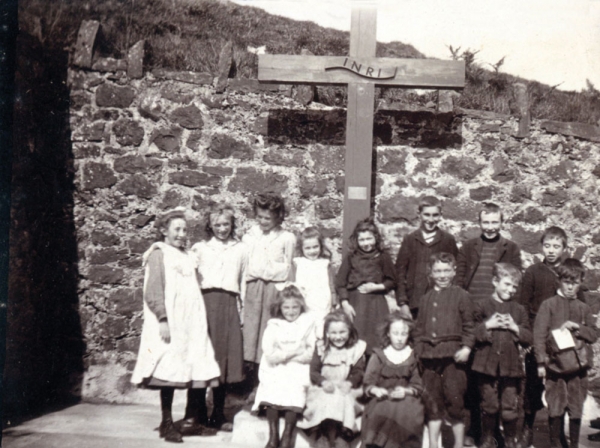
There is a plaque with a list of the priests who served on Rathlin at the back
of the church.
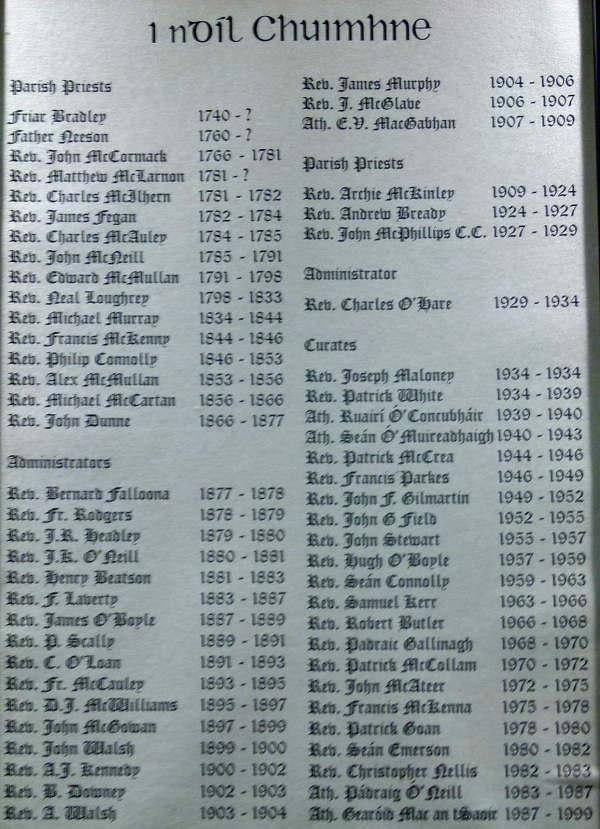
A recording of islanders reminiscences about the chapel is available here.
Looking after the church
The men and boys of the Island would do all the maintenance of the church and the grounds and the women and girls did the cleaning. Some of the island housekeepers who looked after the priests were:
• Kitty McCurdy who looked after Fr McAteer 1987-99 and Fr Boyle 1957-9.
• Cis Cecil who looked after Fr McKenna and Fr Kerr 1963-66 and 1975-78.
• Sadie McFaul who looked after Fr McCrea 1944-49.
• Susan McQuilkin who looked after Fr O’Hare.
• Miss Conway and Mary McCurdy looked after Fr McKinley for 20 years from 1909-1929.
Preserving island history - story telling after Mass
Loughie McQuilkin made his First Holy Communion at the Church in 1930; Fr McPhilipps presided. He received the Sacrament of Confirmation in 1933 from Bishop Mageean. After first Mass on Sunday Loughie and his uncle Alex met up with Mick and Neil Craig of Ushet, George King and Peter McMullan and his son Peter at Carravinally. Here they whiled away the day looking out through the telescope, brought back by Peter from Coatbridge, Scotland, and telling stories. This is where Loughie heard many of the stories of generations gone by, written down in his book ‘Island Reminiscences’ 2013.
Heritage Lottery Fund project
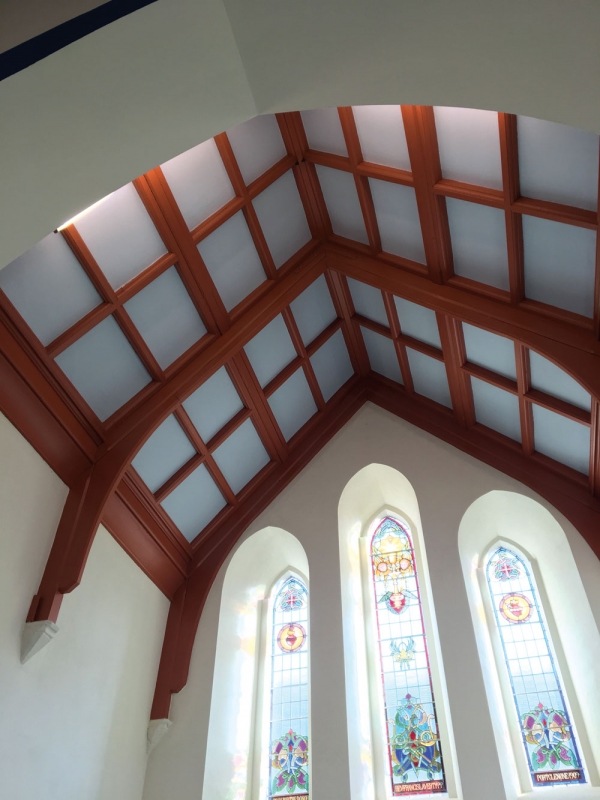
In 2014, the parish applied to the Heritage Lottery Fund for support to address urgent repairs to the church and to make it more accessible to islanders and visitors. A grant was secured to make urgent repairs to the roof, walls and windows and to provide a French drain, install accessible toilet facilities and record the heritage of the church in a leaflet and the parish and island websites. The work was completed in 2017.
St Thomas’ Church

St Comgall founded this Church around 580 as the church for the Monastery which he founded across the Church brae. A new church was built on the site in 1722 when the parish in 1722 was recognised as an independent Parish.
The existing building was built in 1812. It has a castellated bell tower with a single bell. There are Georgian style windows. Inside on the walls are carved memorials. The cross, which used to be on top of the roof in Catholic days, was taken down when it became Church of Ireland, but it re-appeared the next day. This went on for so long that it eventually remained on the roof until that fell into such disrepair that it fell off. It now lies just inside the doorway. (Island Reminiscences by Loughie McQuilkin, 2013.) St Thomas’ was renovated in 2003 and re-hallowed in July 2004.
The graveyard
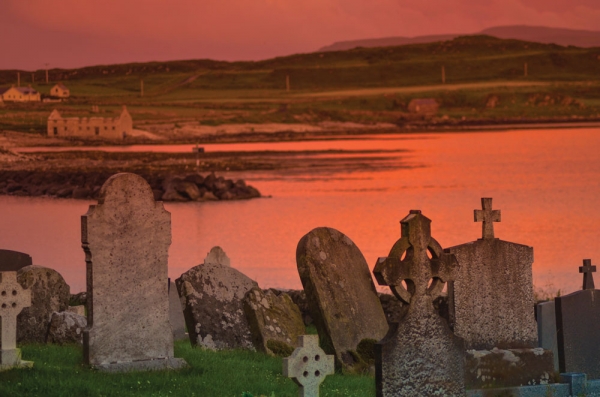
The graveyard at St Thomas’ Church is used as the burial ground for the whole Rathlin community. Behind the church was a walkway to the Manor House. When digging a grave near the Brae a tunnel was discovered linking the church to the monastery on the other side of the road. All that is left of St Comgall’s monastery is a stone seat carved out of rock for the monk’s meditation, and a walled archway leading to the top of the Brae. There are also a number of war graves – one an Island resident and the others are those washed ashore.
Heritage map
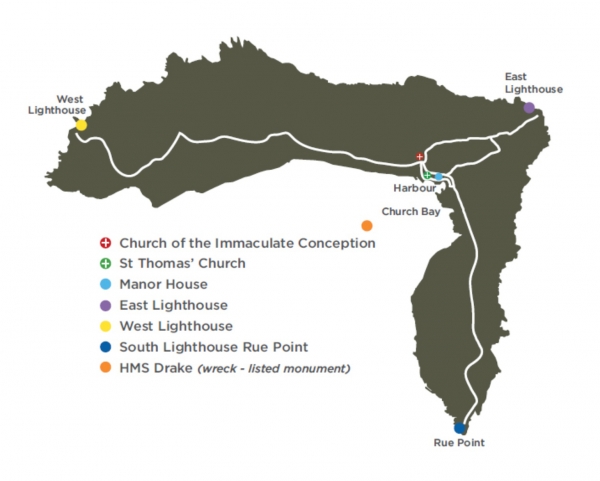
Other key heritage assets on the island - including St Thomas’ Church and the Manor House (both listed B+) and the island's lighthouses.
History of the Island
Rathlin Island lies six miles off Ballycastle harbour and under two miles from Fair Head and 14 miles from the Mull of Kintyre. The island is about 6 miles long and its widest part is barely more than a mile. The higher northern part of the L-shaped island is called Kinramer and the low-lying southern leg Kinkeel. They are connected by the island’s only major road. Church Bay, the harbour and only large settlement is in the corner of the L.
There are three lighthouses on Rathlin Island, a pointer to both its wild coast and its strategic importance at the narrowest point between Ireland and Scotland. The North Atlantic pours into the gap, hitting the tides of the Irish Sea storming out, making a passage that is treacherous to shipping.
People have lived here for at least 8,000 years, making it probably the first Irish island to be inhabited. Ancient axe heads from 5,000BC, Bronze Age graves from 3,000BC and an Iron Age fort from 500BC are among the marks they have left behind.
By the time of the Irish Famine in the 1840’s the population was more than 1,000 and the island is covered with reminders of life during those times. About 500 left Rathlin Island in 1846 on a ship bound for North America, financed by the Gage family.
The population of what is now Northern Ireland’s only offshore inhabited island is now around 140 with numbers boosted in the summer, which brings a growing number of tourists. There are two churches, a Primary School, a Post Office, a shop, a cafe, a restaurant, a pub and accommodation.
The information given in this leaflet is given in good faith on the basis of information submitted to the Parish of Ramoan. The Parish of Ramoan cannot guarantee the accuracy of the information in this leaflet and accept no responsibility for any error or misrepresentation. All liability for loss, disappointment, negligence or other damage caused by the reliance on the information contained in the leaflet is hereby excluded. This leaflet has been developed by the Parish of Ramoan as part of a Heritage Lottery Project to preserve the Church of the Immaculate Conception, Rathlin Island.





